Onlangs zijn in Oud-Charlois door middel van ‘'GPS-tracking'' de beweegpatronen van bewoners van verzorgingstehuis Waelestein in beeld gebracht. De groep werd uitgerust met GPS ontvangers. Door de GPS-tracks te importeren in het Gemeentelijk GIS-web is direct correlatie zichtbaar met o.a. de aanwezigheid van voorzieningen, geluidsoverlast en de veiligheidsindex.
Aanleiding voor dit onder de titel ‘'Assisted Living'' uitgevoerde onderzoek vormt de beleidsvisie ‘'Woonservicegebieden Stadsregio Rotterdam". Ingrijpende wijzigingen van ons zorgstelsel en een veranderende (zorg)vraag van de toekomstige seniorengeneratie noodzaken tot herbezinning op de wijze van ouderenhuisvesting, zorgaanbod en voorzieningen.
De daadwerkelijke totstandkoming van woonservicegebieden vergt nauwkeurig inzicht in de leefpatronen van ouderen. Op basis van een nauwkeurige analyse van beweegpatronen kan een reële oplossing voor (her)programmering van een gebied worden gedaan.
Met een groep internationale masterstudenten van de TU Delft zijn allereerst projectvoorstellen ontwikkeld voor Oud Charlois. Dit op basis van aannames van de toekomstige leefstijl van ouderen. Vervolgens zijn deze plannen getoetst aan de werkelijke beweegpatronen van senioren.
[De volgende werkstukken van de studenten zijn alleen beschikbaar in het engels.]
Lees en download de rapporten hier.
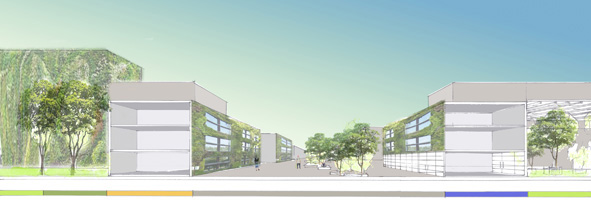
Urban Design 1,2,3 by Antal Bos
The connections between the elderly people and the community in Oud Charlois is broken right now. The elderly people don't participate in the neighborhood by staying in their apartment buildings but by using the facilities and enjoying the public space.
To bring them back we have to provide a barrier free and save environment.
By also spreading the different typologies of care inside the neighborhood, the elderly can profit of each other by socializing and helping each other. This only works if we don't create a senior village but create a balance between family houses and senior houses. There are also great opportunities by using the skill's and creativity of the elderly people. Artist like Marcel Wanders already uses the work of the elderly here in Oud Charlois. This helps them to bring them back in the society and give them pride by the work they've done. We should give the elderly people the opportunity to show that when you are old, it doesn't mean you're burnt down. View Antal Bos's report...

The Interaction Between Public Space and Building Typologies by Anna Duarte
Where do I live when I am old?
With the prosperity of the Dutch society, after the second world war, it became a privilege to place the elderly in big nursing homes. Here the elderly could get all the help they needed, that was maybe not possible to get at home. The relatives could come and visit them now and than, and were relieved with the responsibility of nursing the elderly. Often this homes, regardless of level of assistance they provided, can be located far from the persons neighborhood and social network. This system has now shown to create less healthy elderly, both because they get sicker when they are in a hospital environment and the loss of their social network. This, in combination with and changes of the Dutch society with a larger part of the population coming from other countries and a model for elderly care that has gone old, leads for a search of a new model for elderly care - assisted living.
The question is how the different areas, in this case Oud Charlois in Rotterdam, can implement age care, living, into the existing area? View Anna Duarte's report...
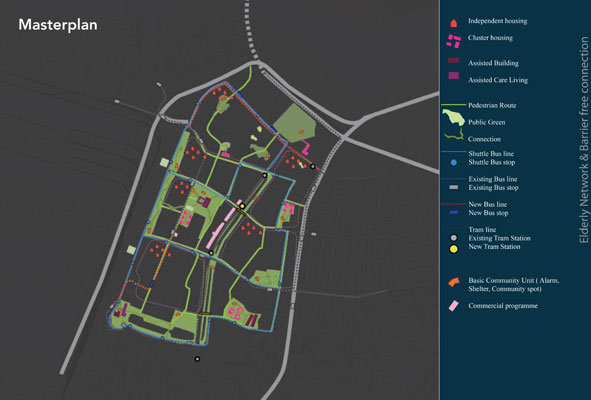
Eldery Network & Barrier Free Connection Introduction by Desponia Spoutzi, Report by D. Spoutzi, H. Lee, Y. Yu, W.P.C. Jelier, N. Kang
The designing task of a ‘adaptation' of a neighborhood to the needs of the future more ‘elder' generations is a rather innovative commission that imposes the necessity of careful planning approach, while at the same time allows the flexibility of interventions. Thus, on the group level we elaborate a Master Plan that covers the total surface of the neighborhood of Oud Charlois and also structures our individual design interventions. Guidelines for its elaboration is a sum of goals which are summarized to:
- stimulate elderly to live independent
- facilitate their connection to the social network of the neighborhood
- the urban regeneration in environmental and economical sustainable terms
Together with this there is a big awareness that elderly are not homogeneous. Different lifestyles and preferences ask for different living environments and facilities.
Facts that in the Masterplan level are translated into a network of housing places and facilities. A diversity of housing typologies and facilities that are shared with other users (non-elderly) as well. Urban interventions for providing those housing and facilities will be combined with improving bad areas in the neighbourhood. Because of dispersing housing and facilities, special attention is paid to traffic: the network of public transport contains a special bus dedicated for less mobile users, car traffic is reduced and streets are designed for pedestrians. Green areas are now often isolated and without a function. In the masterplan a green network is developed, together with the blue network. In the green areas shelters for elderly are provided. View the original report. View the group's report: Part 1 / Part 2 / Part 3
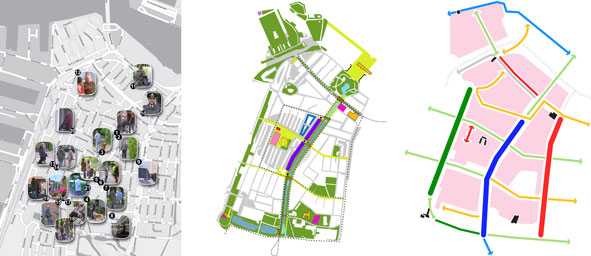
Taking Care of Public Space: Selective Interventions to Heal the Heart of Society by Eline Oort
The assignment of this course is to improve the precarious situation in Oud Charlois, via a focus on the elderly residents. The number of 65+ will extensively grow the coming decades, which is the reason why the municipality of Rotterdam has addressed a number of neighbourhoods as a search area for the new concept ‘assisted living area'. Oud Charlois is one of these ‘woonservicegebieden'. This course made us think of innovative and refreshing ways to implement the ‘assisted living' concept.
Unique about the Veldacademie is that fieldwork is much integrated in the programme. After interviewing over twenty residents of Oud Charlois, I had a clear and broad image of the occurring problems. Problems straight from the hearts of the people. Even though most residents mentioned that Oud Charlois toughens, they do want to stay. Together with analysis of the neighbourhood, it appeared that one of the biggest problems is the visual quality, which is carried out by the public space. Public space is the heart of society, and it is now so called ‘broken'.
The result is a Masterplan which proclaims a concept with life course determined sub-neighbourhoods (with limited radius) surrounded by an interesting, varied, barrier free and well maintained routing. The main north-south axes are inter-connected with east-west linkages. The plan defines three most urgent projects; a multi-functional campus area at Voornsevliet [1], the opening up of the west side of the town canal [2] and an ecological corridor between Karel de Stoutepark and Zuiderpark [3].
The interventions of the Masterplan and Urban design are the healing elements for public space. With the improvement of public space, elderly will stay healthier, will be better able to maintain social contacts and their independency and self-help will increase.
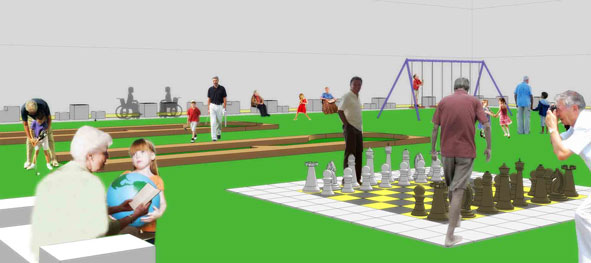
Assisted Living by Francisca Windy
Why elderly?
Why we need to consider elderly when designing a neighborhood? Why we can't just design neighborhood for young people?
The answer is: Because the young will become elderly as well. If we do not make area which is suitable for elderly, when the young become old, they will move out from the neighborhood. The neighborhood will become empty.
Who are they (elderly)?
Elderly people are different from others because of their independency. There are three categories of elderly:
- Independent: They are still active in social life / Significant for them: meeting places, accessible street / Area of life: Oud Charlois
- Part dependent: They are not much active in social life / Significant for them: accessible neighborhood, near to facilities / Area of life: area in the city which is close to all facilities
- Dependent: They have no physical strength or any will for any activity or much social interaction / Significant for them: accessible buildings, near/ combine with kid facilities
/ Area of life: building, room
Focus: Elderly and kids
It will be beneficial to combine kid and elderly. Design proposal will focus to area that has optimal location for elderly and kid. Later on the connection from this area to facilities will also be regenerated.
Design items
Objects for regenerations are: Street profile / Typology / Green space
Ideally, every part in the city supposes to be assisted living. This proposal can be a pioneer and example for other part of Oud Charlois. View Franciska Windy's report: Part 1 / Part 2 / Part 3
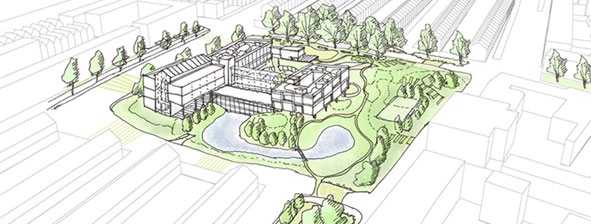
Assisted Living Core by Hyeran Lee
Municipality of Rotterdam, there is a wish to realize such an assisted living area in Oud Charlois. However, there are several urban problems about safety, vacancy and low quality of housing and public space. Developing the assisted living area should therefore be combined with urban regeneration. This project is one of the strategic projects from the masterplan which suggested by the group 'Elderly network and Barrier free connections'.
Many of elderly want to stay in a cherished home for as long as possible. The best option for the assisted living is to make them stay longer and help at their own home. But it's hard to be realized because of limited s pace and budget so that central positioned service core is proposed for Assisted Living area by connecting dispersed facilities and housings within network.
Assisted Living Core, the design project is located on the middle of Oud charlois (within 500m radius from the existing facilities). It is planned to offer various living environment within well connected social network and the most important issue was providing missing programmes and number of elderly housings to cover up Oud Charlois for the future demands.
There is no reference like this clustered village (combining service and housing together) in the Netherlands so that it has risk to be developed by only public sector. To be realized, public-private partnership is needed and compare to existing elderly housings (used to develop by housing corporations), the scale of development will be wider and more complex.
This project will be one of the options for the assisted living area. It is planned to be suitable for Oud charlois but the logic for organizing facilities and making sustainable social network could be experiment for the other locations. View Hyeran Lee's report...

Hybrid Living Unit by Kangnin
In the elderly living structure, the patterns are including integrated service cores and integrated elderly living units.
This project is an elderly living unit. According to the synergy analysis, the north part of Oud-Charlois is suitable for independent living. For the independent elderly people, we also categorized them into different groups by life styles. For this project, I choose the group called "anchored" which have a special like of living in the historic buildings near city centre.
In the north part of Oud-chalois near the church, there two blocks a clusters of old / historic buildings. So precise location is two blocks and the target group is the so-called "anchored group".
The working method is to compare the characters of other aspects of life styles of the target group to the existing physical quality of the site, to find the shortage and the opportunities. And the design goal is to provide suitable houses and semi-public places for the target group.
We do the research of the site in three aspects: housing typology, public space, mobility. For each aspect, we find several problems. And to deal with these problems, we have strategy for each aspect. Combine there strategies I make clear all the interventions should be done in these site. View Kangnin's report...

Cultural Identity & Programme Diversity by Patricia Gavin
An assisted living and mobility programme in Oud Charlois would be a realistic and worthwhile project, investigating a viable alternative to the current care systems, while such a project may function as a catalyst for regeneration and development in the area. It is necessary to pay careful attention to the context and target group of such a development. Oud Charlois is particularly distinguishable by its cultural diversity and could become an example of how such a range of people can be accommodated in an assisted living facility. Although neighbourhood support systems are necessary and important programme diversity is key in allowing for this. Adaptability ensures sustainability as facilities for the current elderly do not go into disuse if culture is diluted in second and third generations. The project therefore seeks to introduce programme diversity by identifying the necessary typologies, assessing the demand of each and implementing them accordingly. Five housing typologies were identified in order to cater for the range of cultural identities; redevelopment of existing, kangaroo housing, family housing, apartments and dependent facilities. Development is dispersed throughout the neighbourhood and connected through a support network and focused on certain cluster points. This network and cluster are then examined in greater detail. In this way it connects with all inhabitants while it also effects a greater area. View Patricia Gavin's report...
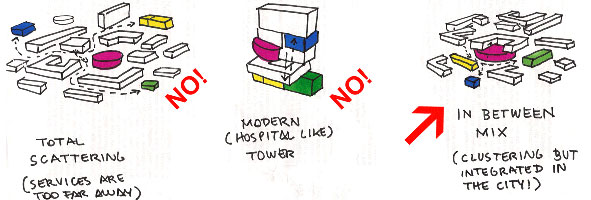
Back to the City by Rafael Alencar-Saraiva
Clusterings of elderly people in parts of the city makes feasible unique programmatic assemblages - composed of swimming pool, medical facilities, workspace, etc - which can be quite desirable environments. Whenever connected to public transportation, these configurations can truly contribute for a more sustainable urban development. View Rafael Alencar-Saraiva's report...

Cultural Identity by Sayali Jadhav and Thao Pham
We carried out interviews in the area to get a review of what and how people feel about their own neighborhood. We also did some research in terms of needs and demands of the elderly. In this area there is a large diversity in cultures and also a lot of social issues to deal with. Due to these problems people were reluctant to make use of public spaces. Hence our strategy is to encourage the participation or elderly in public space. For this we chose to develop the central axis and make stronger connections with the neighborhoods. To convert the central axis which now acts as barrier to a blur and green corridor which merges two sides and forms as the backbone of the area. In the central axis we want to introduce more functions taking advantage of the existing ones and combine these with the public space. These form strong network for social, ecological and economical as they are places where informal contact can result in new acquaintances, friends along the blue and green and also serve as informal markets for services. Along with this we develop the neighborhoods as no car zones and removing the parking along the road and provided parking solutions making it barrier free for elderly. We also design public spaces on various scales and types. We also make use of the green, solar and water to make sustainable neighborhoods which can be more accessibly not only in summers but also in winters. This will make the area more lively and livable. View the report...

Urban Regeneration and Assisted Living / Linear park = Synergy by Silvia Balzan and Amandine Mennechez
The project reflects on the urban regeneration of Oud Charlois, through the introduction of Assisted Living Areas for elderly people. The intervention is constituted by two new concentration elders housing areas, one situated in the north part and one in the south part of the district. By this way, the main goal is balancing the different featured parts of the settlement, in order to create a well served and efficent area in the middle. Through the implementation of the daily facilities' number, the project wants to provide a new commercial circuit that conduct the people from the north to the south in a smarter way. The realisation of a new community centre, as new point of the attraction in the south part, gives the altenative to the historical centre in the north. The attractions will be connected through a Linear Park, built on the existing blue, green, grey axis, but more extended. This new public space ( with added recreational shared facilities ) will be the element will constitute the synergy with a free barrier community network, not only for elders. The park will give the chance to Oud Charlois to become a very accessible and friendly place to live. View the report: Part 1 / Part 2
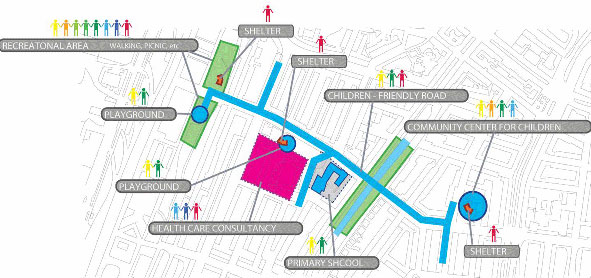
Ontmoeten en verplaatsen by Wimco Jelier
Ontmoeten en verplaatsen, de leidende principes voor in inrichten van de openbare ruimte van Oud Charlois. Ontmoeting door straat als verblijfsruimte: uitnodigende vormgeving en ouderenvoorzieningen gericht op openbare ruimte. Verplaatsen: prioriteit bij langzaam verkeer. Voor voetgangers netwerk van rustpunten. View Wimco Jelier's report: Part 1 / Part 2
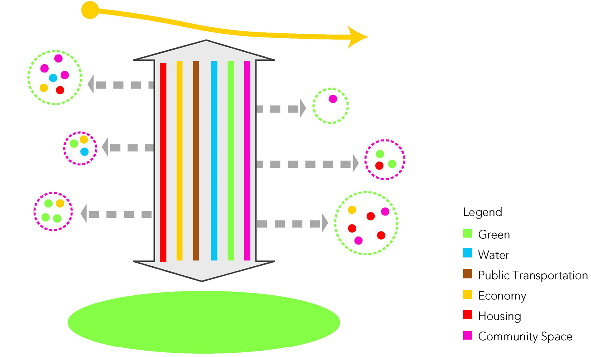
Green Social Backbone by Yu Yu
Like the group work (Elderly Network & Barrier Free Connection), the individual project also focuses on two parts: Urban Regeneration & Assisted Living
For the urban regeneration part, I try to solve the physical problems, such as lack of facilities, low mobility, bad quality of housing, etc.
For the assisted living part, social network is the anchor point, which is essential for elderly people, according to my analysis.
By providing new facilities, housing, road connection for elderly people and younger ones as well, in the urban regeneration part, the social network can be fixed and developed accordingly, which decides that a synergic methodology is needed.
In this way, my individual project is related with other four individual projects done by other group members, and can be seen as a part of the group plan and design.
However, my individual project is rather independent. Since the main axis is a very outstanding feature in this site, I believe it can not only provide facilities and services within its territory, but can also support the development of other areas, which is the most significant and special character it has.
Based on the reasons mentioned above, the plan and design are both focused on four parts:
Green / Blue
Mobility
Facilities
Living
By dealing with the four parts, the social, ecological and economic issues can be covered at the same time.
In the individual design, through fixing the physical network and providing new facilities and services points in order to implement urban regeneration in Oud Charlois, I try to connect and strengthen the social network between elderly people and integrate the elderly network with general network based on the different life styles of people at different ages, which is the same way as we did for the group work.
I would like to go further to support our group work, and at the same time, revise the former group work.
In the end, the result of GPS research is used to evaluate the project. View Yu Yu's report...
Toekomst
Vanwege het beperkt aantal tracks is de wetenschappelijke significantie van het onderzoek momenteel niet aantoonbaar. Wel vormen de actuele resultaten een goede opmaat voor een grootschaliger en bredere aanpak. In samenwerking met o.a. Sikko Bakker (SoZaWe), Mark Verschuur (GIS diensten), Stefan van der Spek en Frank van der Hoeven (TU-Delft) worden momenteel voorbereidende stappen gezet. Toekomstige onderzoeksvoorstellen en resultaten van het "Assisted Living " onderzoek zullen 15 oktober aanstaande gepresenteerd worden op de Conferentie Woonservicegebieden te Rotterdam.
Voor meer informatie over de conferentie neemt u graag contact op met de Veldacademie.